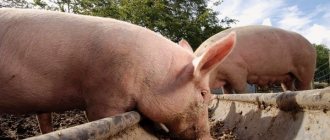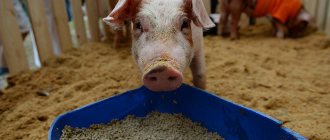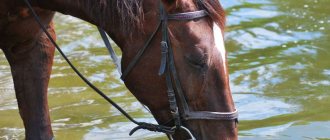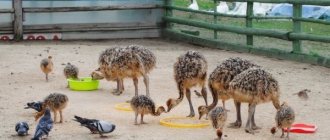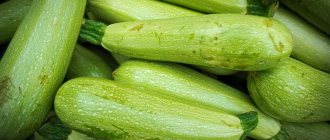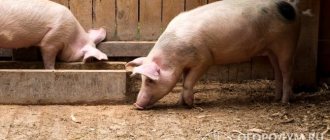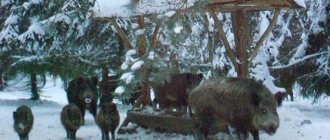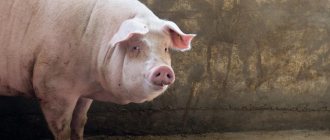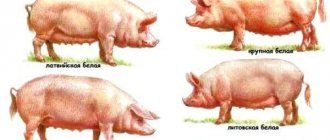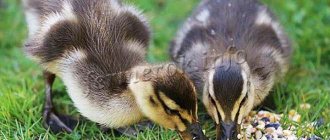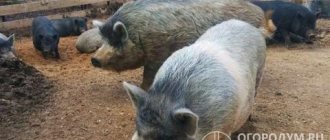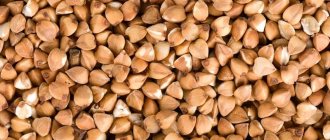The rate of weight gain in a pig depends on the diet and characteristics of the breed. The farmer needs to monitor the weight of growing animals to identify deviations in the development of piglets and obtain the expected profit from meat products.
To calculate the difference between the real weight of a pig and the norm, you need to know how much a pig should weigh monthly, and how to determine the weight with an accuracy of 1 kg without using scales.
Types of feed and their daily consumption rates
When choosing a breed of pigs for fattening, you need to know in advance what you are going to feed them, since the diet will depend on the breed. Table 1 shows which feeds are recommended for different breeds of pigs.
Table 1
| Breed | Recommended type of food |
| Mirgorodskaya | Juicy, green |
| Ukrainian steppe | |
| Large white | |
| Landrace | Concentrated feed |
| Duroc | |
| Wales |
Sick animals should not be fed for meat, especially if they are infected with tuberculosis, Finnosis, infectious and inflammatory diseases.
Farmers use different feeds and products to fatten pigs. The complex of feed provided should provide the animal with energy and a full range of nutrients.
Leaning on fiber - bran, the pig spends a lot of energy on digestion. Therefore, such food should be given in limited quantities. Most of the feed should be concentrated feed. Violation of this principle leads to a negative result - the pig does not gain weight.
The feed given to pigs is divided into 3 main groups, each of them has a different effect on the taste and quality of the meat. The influence of feed groups on the quality of meat and lard is shown in Table 2.
table 2
| Group No. 1 – improves the quality of meat and lard | Cereals – peas, millet, barley |
| Vegetables, root vegetables, melons | |
| Herbs – fresh and hay (nettle, alfalfa, clover) | |
| Meat and dairy waste | |
| No. 2 – deteriorate the quality of meat and lard | Bran – wheat and rye |
| Buckwheat | |
| Corn | |
| No. 3 – given at the initial stage of fattening | Oats |
| Soybeans | |
| Cake |
Group No. 3 is excluded from the diet 2 months before slaughter.
Concentrated feed
Concentrated feed is crushed feed made from cereals, bran, legumes, and grain processing waste. This food provides animals with energy, and legumes provide proteins.
The most popular crop for fattening is barley. It is digestible by 80% and improves the taste of pork. Composition of concentrated feed:
- oats - they are given only at the initial stage of fattening;
- millet;
- corn - it is mixed with food containing protein;
- steamed peas;
- cake and meal (soybean, sunflower, flaxseed);
- bran - you can’t give too much because of the high fiber content.
Concentrated feed is given in crushed form.
Remember when feeding livestock:
- Finely ground turd is given only in combination with food waste or succulent food - this prevents disruption of the stomach and intestines.
- Grain feed is not boiled - heat treatment leads to the destruction of active substances.
- Beans must be boiled - they are poorly digestible in their raw form.
The feeding standards for pigs with concentrated feed are presented in Table 3.
Table 3
| № | Culture | Amount of feed, kg (for a pig weighing over 50 kg) | Daily requirement, feed units | Number of feed units in 1 kg of feed | Weight gain, kg |
| 1 | Wheat | 2,1-2,4 | from 2 and above | from 1.2 | 0,5 |
| 2 | Barley | 2,3-2,5 | from 2 and above | 1,21 | 0,5 |
| 3 | Corn | up to 2 | from 2 and above | 1,34 | 0,5 |
| 4 | Peas | from 2 | from 2 and above | 1,17 | 0,5 |
| 5 | Rye | 2 | from 2 and above | 1,18 | 0,5 |
| 6 | Oats | 2,1 | from 2 and above | 1 | 0,5 |
| 7 | Millet | 2,3 | from 2 and above | 0,96 | 0,5 |
Juicy food
The most valuable succulent crop is potatoes. It is absorbed by 94%. Potatoes are given mixed with protein-containing food - peas. Potatoes are given boiled. Among the succulent feeds fed to pigs:
- Boiled beets.
- Carrots are needed by suckling piglets.
- Pumpkin – given to all age groups.
Food waste
To feed livestock you can use:
- uneaten food;
- crackers;
- waste remaining after cutting fish and animals;
- raw and boiled vegetables;
- cleaning fruits and root vegetables.
Before slaughter - several weeks before, you need to remove fish waste from the diet, otherwise the meat will become tasteless.
The waste is placed in clean containers and given to the pigs.
The diet of pigs can be varied with acorns. One individual is given up to 2 kg per day. Pigs will not refuse mushrooms either - they are placed dried or boiled in mash.
Green food
The most important herb in pig nutrition is nettle. It can be mowed anywhere, it grows everywhere. Nettles are harvested for winter food by drying young shoots. Portion – 300 g per day.
After 6 hours, the chopped green mass loses half of its benefits. If nettle is left brewed to cool, it can cause intoxication.
Another valuable green crop is rapeseed. It contains a lot of proteins and fats. Thanks to rapeseed cake, animal growth is accelerated by 4%. Rapeseed contains much more phosphorus, magnesium, calcium and copper than soybeans. If you want to increase the profitability of fattening, it is better to replace sunflower and soybeans with rapeseed.
It is useful to feed pigs “green stuff” - this is grass and leaves in crushed form. Components of the green stuff:
- peas;
- oats;
- quinoa;
- nettle;
- alfalfa;
- clover;
- beet tops.
In winter, instead of green fodder, combined silage is given. It is prepared for future use from the following ingredients:
- fresh grass;
- vegetable waste;
- roots;
- chaff;
- hay or grass flour;
- carrot.
Animal products
Pigs fattened for meat can be given animal feed:
- Milk. Only sucklings are fed undiluted milk. Adult animals are fed buttermilk, skim milk, and whey.
- Fish or meat. They give it for the sake of protein. You can donate animal and fish waste. The fed fish must be boiled.
Yeast feed
Yeast contains a lot of vitamins and proteins, which are almost completely absorbed by the body. The productivity of weight gain, thanks to yeast feed, increases many times over. They produce special yeast - feed yeast. Table 4 shows the composition of yeast.
Table 4
| Yeast composition | % |
| Protein | 32-38 |
| Alimentary fiber | 1,8 |
| Fat | 1,8 |
| Cellulose | 1,2-2,9 |
| Protein | 38-51 |
| Ash | 10 |
Tips for beginners:
- It is recommended to ferment 30% of the feed or more. For example, if you give a pig 2 kg of feed mixture per day, then 600 g of feed must be mixed with a yeast additive.
- You can replace feed yeast with baker's or brewer's yeast.
What supplements are needed?
By flavoring food with additives - flavoring and aromatic, it is possible to improve digestion and the secretion of gastric juice - by irritating the receptors. Aromatic oils are used to activate taste buds:
- citrus fruits – lemon, tangerine;
- cinnamon;
- sage;
- caraway;
- dill.
The pig family will not refuse to taste sweets. To give the pigs a taste pleasure, the following is added to their food:
- 2.5% sugar;
- 5% ground dry beets.
Pigs prefer sour tastes to alkaline ones. To create it, organic or inorganic acids are added to food - lactic or acetic, within 0.4% of the serving weight. To add bitterness to the food, add 0.15% mustard or 0.4% calcium chloride.
For better digestibility and desire to eat, animals are given food with sweet, sour or bitter additives. Among the important additives is citric acid. In the body it performs the following functions:
- reducing the risk of infection;
- normalization of pH levels;
- high-quality digestion of food;
- normalization of microflora.
The addition of citric acid allows you to increase weight gain by 9-17%. Recommended content is 1% of the feed weight.
Pigs are given mineral supplements - the following is added to the feed:
- ash or coal;
- calcareous tuff;
- chalk;
- eggshell.
Small doses of antibiotics must be added to the feed - they reduce the incidence of disease and increase weight gain by 15%. The drugs used are Biovit-20, Terravit-40 and others. They should be given after consultation with a veterinarian.
Why do you need flax supplements?
Pure flax cannot be given to pigs. But flax is given in small doses for diarrhea, as it has a strengthening effect. Large doses deteriorate the quality of meat and lard - they acquire a yellowish tint and emit a fishy smell.
But flaxseed cake is very useful for pigs. He contains:
- protein – 28%;
- moisture – 11%;
- fat – 9%;
- extractives.
When the cake swells in water, mucus is released, which protects the walls of the stomach from irritation.
Achieving low fat
Meat fattening of pigs is the most effective and popular on pig farms. Typically, a fattened piglet eats feed that can be classified as the first group - rye, pumpkin, wheat, peas, combined silage, dairy waste. As a result, the product turns out tender, soft and juicy with a thin layer of bacon.
Potatoes, wheat bran, buckwheat and corn (second group) make pig meat loose. Fish waste, oats and cake (third group) give it an unpleasant taste.
The best ratio in the menu is considered to be 40% of the first group of feed and 60% of the second. If food products of the third group are used, they can be taken 20%, the second - 50%, and the first - 30%. When there are 2 months left before slaughter, the feed of the third should be completely excluded from the diet.
Feeding pigs for rapid growth is best done during warm periods - spring or summer - because there is access to inexpensive and nutritious food. Green food at this time makes up 30% of the diet. There is also an abundance of melons, root vegetables, and legumes. In winter they are replaced with combined silage and grass meal.
How to prepare food?
Any feed requires some kind of preparation before being given to pigs. Thanks to feed processing:
- their nutritional value increases;
- their digestibility improves;
- they are disinfected.
There are several methods for preparing feed:
- Mechanical. The ingredients are crushed, crushed and mixed. The nutritional value and palatability of feed increases.
- Chemical. The ingredients are treated with alkali or acid - this method is used for difficult-to-digest substances.
- Biological . It consists of a partial change in the chemical composition. Achieved by silage, fermentation, germination, etc.
Preparing vegetables
Potatoes are the main fodder root crop. Piggies do not digest raw potatoes well; it is recommended to boil and mash them. Potatoes are given to pigs mixed with grain or green feed.
The water in which the potatoes were boiled is drained - it is harmful to pigs, as it contains poisonous solanine.
Other vegetables - beets, carrots, pumpkin, grate on a coarse grater before serving. They are given raw. Rub before eating. You should not make preparations - the vegetables spoil and become inedible.
Vegetables and root crops become more nutritious after processing, and animals digest them better. Beets and pumpkin can be boiled, and boiling water can also be given.
Hay and dust
In order for roughage - hay and hay dust - to be better digested in the stomachs of pigs, they are steamed with boiling water for 2-3 hours. Before steaming, the hay is crushed.
Cereals
The most difficult thing is to prepare the grain. You should not give either dry or raw grain to pigs - there will be no benefit from it. At a minimum, the grain needs to be ground. The finer the grind, the more benefits there will be.
What you need to know about grain grinding:
- Oats and corn are ground as needed - there is no need to store them for future use, since the fat contained in the grains, oxidizing, makes the ground grain rancid.
- Beans and lentils must be boiled - without this, their digestibility is minimal.
Before giving the ground grain to suckling piglets, it is first roasted until dark brown.
To increase the nutritional value, the grain is germinated in boxes under the sun. The grains are watered for 10 days. You can give grain when the sprouts grow to 10 cm in length. This food is usually given to piglets and sows.
Green food
Green grass is not given to pigs without pre-treatment. It is thoroughly crushed so that there are no dry, coarse stems in the green mass. It is not recommended to harvest grass for future use - it will become lethargic, may rot, and there will be no benefit from such food.
Combisilos
To prepare combisilos, beets, cabbage, carrots, lupines, as well as green mass of legumes and corn are chopped. Important points for preparing combisilos:
- All vegetables and herbs have a period in which they are best ensiled - when the maximum benefit can be extracted: corn is ensiled when it reaches milky-waxy maturity;
- lupine and peas - before flowering;
- Jerusalem artichoke, pumpkin, carrots - after full ripening.
Table 5 presents several popular combisilage recipes:
Table 5
| Ingredients | Percentage, % |
| Recipe No. 1 | |
| Potato | 40 |
| Clover | 30 |
| Carrot | 15 |
| Cabbage | 15 |
| Recipe No. 2 | |
| Sugar beet | 50 |
| Carrot | 20 |
| Hay dust | 10 |
| Green legumes | 20 |
| Recipe No. 3 | |
| Corn (cobs) | 60 |
| Pumpkin | 30 |
| Green mass of legumes | 10 |
| Recipe No. 4 | |
| Sugar beet | 40 |
| Clover | 30 |
| Potato | 30 |
| Recipe No. 5 | |
| Carrot | 20 |
| Corn (cobs) | 80 |
What to feed for fast growth
In order for growing individuals to rapidly gain weight and not lag behind in physical development, it is necessary to provide a comprehensive and balanced diet. Accelerated growth is promoted by a combination of the following products:
- cereals;
- vegetables and juicy root vegetables - potatoes, pumpkin, beets, carrots;
- roughage - dust from legumes;
- grass feed, including a number of plants;
- dairy products and fish and meat waste.
These products have a positive effect on the taste of meat products, activate growth, and increase the graininess and density of lard. A comprehensive diet provides animals with a sufficient amount of vitamins required for the development of the body.
Feeding regimens
For good weight gain, pigs need the right diet. Feeding standards for pigs fattened for meat are given above in Table 5.
Feeding of animals of different ages and intended purposes is presented in Table 6.
Table 6
| Animal category | Number of feedings per day |
| Pregnant sows | 1 |
| Single and suckling sows | 2 |
| Growing piglets | 3 |
| Fattening pigs | 3 (regular feed – 2, roughage – 1) |
There are 3 feeding schemes to choose from:
- No norm. For young animals. Babies who have finished milk feeding are fed as much as they want. The food is always present in the feeder. Food dishes are cleaned a couple of times a week.
- According to the norm. Food is provided according to needs. Standards depend on scientific recommendations and personal experience. Feed is supplied 3-4 times a day. Suitable for suckling sows and growing piglets.
- With restrictions. Allows you to get lean meat.
For good weight gain, special nutrition is provided. For feeding standards for pigs fattened for meat, see Table 7.
Table 7
| Weight, kg | Gain, g | Feed units | Protein, g | Carotene, g | Salt, g |
| 14-20 | 300-350 | 1,3-1,5 | 165-190 | 130 | 12 |
| 20-30 | 300-400 | 1,4-1,7 | 175-215 | 125 | 14 |
| 30-40 | 300-400 | 1,5-1,8 | 180-225 | 125 | 15 |
| 40-50 | 400-450 | 2-2,3 | 220-265 | 115 | 20 |
| 50-60 | 400-500 | 2,1-2,4 | 240-275 | 115 | 22 |
| 60-70 | 500-600 | 2,6-3 | 260-330 | 110 | 25 |
| 70-80 | 600-700 | 3,2-3,7 | 320-390 | 110 | 32 |
| 80-90 | 600-700 | 3,3-3,8 | 330-410 | 110 | 32 |
| 90-100 | 700-800 | 3,9-4,4 | 355-415 | 95 | 35 |
| 100-110 | 700-800 | 4-4,5 | 360-420 | 95 | 35 |
Feeding phases
Fattening pigs involves single or multi-phase feeding:
- Single-phase feeding. This method does not take into account the nuances of the livestock. The piglets are gradually transferred to the diet of fattened pigs. The animal body receives more proteins than it needs, and there is also an excess of phosphorus and nitrogen. The downside is the high cost of feed.
- Multiphase nutrition takes into account the needs of the body. A more complex option, but profitable. As individuals grow, they eat more, but they no longer require as much protein as at the beginning. The multiphase method involves reducing the proportion of nutrients and the release of phosphorus and nitrogen by 20%. With a two-phase method, feed changes occur when the animal reaches 70 kg, with a three-phase method - 30-60 kg, 60-90 kg, 90 kg and more.
Infectious diseases of pigs
The causative agents of such diseases are opportunistic microflora and various viruses. The severity of such diseases is largely due to their gradual progression. First, there is an incubation period when the pathogen does not manifest itself. Then the so-called begins. period of precursors - at this time the first symptoms appear. If preventive measures have not been taken, then the infection enters its most dangerous stage of development. If the treatment results are positive, the disease subsides and the animal recovers. Otherwise, his death follows. However, despite the development of the veterinary industry, not all infectious diseases can be treated - in some situations, not only infected animals are destroyed, but also individuals who have come into contact with them.
Types of feeding
There are 2 types of feeding - dry and liquid. Both versions have pros and cons. The choice of technique is the owner’s decision. Let's consider both options.
Dry method
80% of farmers use dry feeding. Its advantages:
- the food is balanced;
- compliance with sanitary and hygienic indicators;
- good absorption of nutrients - thanks to heat treatment.
Disadvantages of dry feeding:
- the likelihood of gastrointestinal disease increases;
- animals, moving between feeders, scatter food - losses reach up to 9%;
- the room becomes contaminated with dust particles from feed - the risk of pulmonary diseases increases, both in animals and in farm workers.
When dry feeding use:
- complete food;
- grain mixtures with bran, cake, premixes.
Feeding frequency – 2-3 times a day. Animals must have unlimited access to water.
Liquid method
This approach is used in some European countries. Liquid feeding is popular among farmers in Denmark, Germany, France, and Finland. Advantages of the method:
- The use of waste reduces the cost of cereal feed and reduces the cost of pork. In particular, secondary products from the food and microbiological industries are used.
- Feeds meet the biological needs of animals.
- Gradual change in diet.
- Precision in dosage and the ability to adjust the diet.
- You don't have to install drinking bowls.
- Less manure.
- Feed costs are reduced by 10%, and growth increases by 6%.
Flaws:
- The need to regularly monitor the sanitary condition of feeders.
- Short shelf life of liquid food.
- Increased humidity in the room is bad for the health of animals during the winter season.
- You have to monitor the moisture content of the mash. If the fluid norm is exceeded, the flow of food through the gastrointestinal tract is accelerated for 8-10 hours. This reduces the quality of digestion and absorption of nutrients.
Growing up
When they reach a weight of up to 25 kg, individuals already belong to the category of gilts. Their intensive growth and development of the body determines the need for large amounts of nutrients and useful elements. To achieve nutritional value of feed, dry concentrated mixtures are supplemented with green grass and vegetables.
Freshly cut grass must be chopped. It’s easy to pour boiling water over part of the mass, then mix with boiled potatoes and other vegetables. Dry feed mixtures are also added to the warm mass. Some of the herb can be given fresh.
When an individual weighs about 45 kg, it is time for intensive fattening using a special diet. The composition of feed at this stage depends on the final purpose of breeding. The meat trend predominates, although sometimes individual animals are fattened specifically for lard.
The normal indicator is considered to be 650 grams of weight gain per day. It is not difficult to increase this figure by introducing into the feed menu especially nutrient mixtures that contain a minimum of fiber. By the age of 6 months, the live weight of the individual reaches a hundredweight.
Fattening methods
The pig body is designed in such a way that, depending on feeding patterns and diet, it is possible to influence weight gain and the type of product obtained. There are three fattening options - meat, lard and bacon.
For meat
Meat pigs weigh 60-130 kg Their characteristics:
- developed hams;
- rounded body;
- The thickness of the back fat is 1.5-4 cm (zone 6-7 ribs).
For fattening, young animals weighing 15-16 kg are taken for meat. To obtain high-quality meat, piglets are fattened in stages:
- Preliminary – 3-3.5 months.
- Final – until fattening is completed.
The amount of protein received by pigs fattened for meat is presented in Table 10.
Table 10
| Age, months | Amount of protein, g per 1 feed unit |
| 2-4 | 129 |
| 5 | 110 |
| towards the end of fattening | 90-110 |
If pigs do not have enough protein, obesity progresses and growth slows down. Daily consumption rates for pigs fattened for meat are in Table 11.
Table 11
| Name of substance, % | Weight 40-70 kg | Weight 71-120 kg |
| Calcium | 0,78 | 0,81 |
| Phosphorus | 0,7 | 0,67 |
| Salt | 0,58 | 0,58 |
| Lysine | 0,7-0,73 | 0,6-0,65 |
| Methionine + cystine | 0,45-0,47 | 0,34-0,42 |
The source of amino acids and proteins is fish and meat and bone meal, in the following dosages:
- meat flour – 100-300 g;
- meat and bone – 100-250 g;
- fish – 100-200 g.
Giving pigs 200-700 g of feed yeast per day can increase weight gain by 15% and reduce feed consumption by 11%.
Pigs are fed 2-3 times a day. Feed digestibility coefficient – from 80%. The food contains potatoes, its coefficient is 94%. In winter, fattened animals must be given:
- silage corn;
- potato;
- sugar beets;
- combisilos.
In summer, the amount of potatoes is reduced, replacing it with peas, corn, and alfalfa.
On to the bacon
Fattening for bacon is divided into 2 stages.
Up to 5 months. When the first period ends, the animal reaches 57 kg. The feed mixture should contain grains, grain processing waste, grass, legume cake, and in winter - legume hay. Percentage of concentrates mixed with:
- potatoes – 42-65%;
- root crops – 70%.
A kilogram of mixture should contain 120 g of protein. 2.5 kg of skim milk is given daily.
From 5-7 months. They stop dispensing meat flour, fish, oatmeal, soybeans and grain hulls. To improve the quality of bacon, animals are given peas, vetch, barley, and millet. The mixture should contain 100 g of protein. 30% of grains are subjected to yeast.
The composition of the concentrate for fattening pigs for bacon at different periods is presented in Table 12.
Table 12
| Name of food | % content |
| First period | |
| Barley | 45 |
| Pulses | 20 |
| Corn, oats | 15 |
| Cake | 5 |
| Second period | |
| Pulses | 20 |
| Fine wheat bran | 10 |
| Barley | 70 |
Pigs fattened for bacon are restricted in their mobility. They are only occasionally released into pens.
For lard
Pigs aged 2-2.5 years are fattened for lard. Any breed is suitable. Males must be castrated. Carbohydrate foods should make up 50% of the total feed mass. Also, a lot of succulent food is introduced into the diet. Towards the end of fattening, the proportion of concentrates should be increased.
The diet includes:
- beet tops;
- roots;
- melons;
- waste – food and vegetable;
- nettle, etc.
Fattening for lard is divided into three stages. Nutritional norms for different periods are presented in Table 13.
Table 13
| First stage | |||
| winter | summer | ||
| Food waste | 6 kg | Food waste | 2 kg |
| Concentrates | 4.5 kg | Concentrates | 5.3 kg |
| Beet | 6 kg | Beetroot and potatoes | 4 kg |
| Salt | 65 g | Salt | 50 g |
| Chalk | 20 g | Chalk | 20 g |
| Herbal meal | 1.5 kg | Greenery | 10 kg |
| Second phase | |||
| Food waste | 6 kg | Food waste | 1.2 kg |
| Concentrates | 4.9 kg | Concentrates | 6 kg |
| Beets, potatoes | 6 kg | Beet | 4.5 kg |
| Salt | 70 g | Salt | 60 g |
| Chalk | 20 g | Chalk | 40 g |
| Herbal meal | 1.5 kg | Greenery | 6 kg |
| Third stage | |||
| Food waste | 3 kg | Food waste | 1.5 kg |
| Concentrates | 5.2 kg | Concentrates | 5.5 kg |
| Beets, potatoes | 9 kg | Beet | 5.5 kg |
| Salt | 75 g | Salt | 55 g |
| Chalk | 40 g | Chalk | 30 g |
| Herbal meal | 1.5 kg | Greens, potatoes | 9 kg |
Pig weight achieved at the end of each stage:
- first – 150-200 kg;
- second – 210-260 kg;
- third - from 260 kg.
Is it possible to fatten pigs with bread?
Nothing bad will happen to pigs fed on bread. However, experts do not recommend feeding animals with bread alone - you must definitely mix it with juicy feed and bran.
Only fresh bread should be given - it is strictly forbidden to feed moldy products to pigs, as they contain poisons. You can feed them bread, but you won’t be able to fatten them up quickly.
Grind and sprinkle with salt
For any options for fattening pigs on farms, you must adhere to the immutable rules for pig farming:
- You can’t feed leftovers from yesterday’s food, everything is only fresh;
- when adding grain, vegetables, and vegetation to the main feed, all this is crushed for better absorption by the pig’s body;
- The temperature of the food should be cool, not hot;
- proteins and amino acids are barley, soy, fishmeal and calcium-containing products; they are added to the main meal;
- The food should contain salt - up to 40 g, for better absorption of food by the pigs' stomach.
Compliance with these rules will provide the animals with adequate nutrition and protect them from many diseases, which means they will grow well and gain weight quickly.
In pig farming, a good indicator is low feed costs, but at the same time the pigs have good weight gain. This is feed conversion with a low coefficient (the ratio of spent feed to a unit of product received, for example, to 1 kg of weight gain). If it is high, it means a lot of food is wasted and keeping animals is unprofitable.
Each pig fattening technology was developed to produce different products (meat, bacon, lard) on favorable terms. We will talk about each of them below.
Feeding ration
The norm for average daily weight gain is considered to be 650 g; at the age of 6 months, the pig reaches 100-120 kg. Costs per 1 kg of weight should not be more than 4 feed units.
Piglets move into the category of “adult pigs” upon reaching a weight of 40-50 kg. Nutrition is selected depending on the purpose of the animal. Let's consider the nutritional features for different categories of pigs.
Feeding boars
When fattening boars, it is important to control their condition - emaciated or obese individuals lose sexual activity and productivity. During the breeding season, animals need to increase the amount of feed, as their metabolism accelerates.
If boars are limited in copulation, nutritional standards are reduced by 10-20%. The volume of dry food is measured based on 100 kg of live weight. Growing children receive – 1.6 kg, adults – 1.4 kg. The basis of the menu is cereals, cake, meal, meat and fish waste, peas.
An approximate daily ration for an adult boar is given in Table 14.
Table 14
| Feed, kg | During the mating period | In a non-random period | ||
| in summer | in winter | in summer | in winter | |
| Concentrate mixture | 2,9 | 2,3 | 1,5 | 1,1 |
| Peas broad beans | 0,9 | 0,8 | 0,4 | 0,4 |
| Combisilos | — | 4 | — | 4 |
| Herbal meal | — | 0,5 | — | 0,5 |
| Return | 2,5 | 3 | 1 | 1 |
| Grass | 3 | — | 4 | — |
| Chalk, g | 20 | 40 | 15 | 30 |
| Salt, g | 45 | 50 | 35 | 40 |
| Number of feed units in the diet | 4,9 | 4,9 | 3,8 | 3,8 |
| Digestible protein, g | 690 | 690 | 420 | 420 |
Feeding suckling sows
The farrowing sow, immediately after the appearance of the piglets, is given plenty of warm water. The first feeding is after 10-12 hours. She is fed liquid mash, which is prepared from:
- oatmeal and wheat bran;
- chalk and table salt - 20-30 g each;
The second feeding is after 5-6 hours. The daily norm is increasing gradually. The sow is transferred to the full feed allowance only by 6-8 days. During the first 10-20 days, the pig is fed liquid feed to enhance lactation. At the end of the first suckling period, the queen is given porridge-like food. Feeding suckling queens - twice a day.
During the suckling period, it is recommended to give per day:
- legume hay flour – 2-3 kg;
- potatoes – 3.5 kg;
- root vegetables – 4-5 kg;
- silage – 2-3 kg;
- concentrates – 3-5 kg;
- return – 2-4 l.
An approximate diet for lactating sows is given in Table 15. Data for a pig weighing 180-200 kg, nursing a dozen piglets.
Table 15
| Indicators, kg | Winter period | Summer period | ||
| Potato concentrate | Concentrated root vegetable | Concentrated | ||
| Barley | 2,5 | 0,4 | 1,2 | 1,7 |
| Wheat | 0,6 | 3 | 2,4 | — |
| Corn | — | — | — | 2/3 |
| Peas | 0,2 | 0,4 | 0,4 | 0,2 |
| Herbal meal | 0,7 | 0,7 | 0,7 | — |
| Sunflower meal | 0,4 | 0,2 | 0,3 | 0,3 |
| Fish meal | 0,2 | 0,2 | 0,1 | 0,2 |
| Return | 1 | 1 | 1 | 1 |
| Steamed potatoes | 5 | — | — | — |
| Semi-sugar beets | — | 6 | — | — |
| Green mass of legumes | — | — | — | 6 |
| Combisilos | — | — | 3,7 | — |
| Indicators, g | ||||
| Precipitate | 57 | 59 | 71 | 44 |
| Salt | 30 | 30 | 30 | 30 |
| Premix | 60 | 60 | 60 | 60 |
| Feed units | 6,8 | 6,8 | 6,8 | 6,8 |
| Digestible protein | 764 | 764 | 764 | 761 |
Feeding single and pregnant sows
Their fertilization, fertility and health of newborns depend on the quality of feeding of single queens. It is important to provide a high-quality diet, starting with preparation for mating. The egg matures in 20-22 days. That is, preparation of the uterus should begin a month before mating.
The diet of single queens should include:
- food rich in protein - fish waste, small fish (serrat), various seafood, flaxseed cake;
- concentrated feed;
- clover hay;
- silage;
- potato;
- carrot.
In the second half of pregnancy, they begin to provide feed of the highest quality. Towards the end of the period, the amount of roughage and succulent food is gradually reduced. Half a month before the birth of piglets, the pig is fed skim milk - 0.5-1 liters. 3-5 days before the interview they stop giving milk. The amount of feed is reduced to 50% of the diet. Diets for single and pregnant sows - in the first and second half of pregnancy - are given in Tables 16 and 17, respectively.
Table 16
| Feed, kg | winter | summer | ||
| Uterus up to 2 years (150 kg) | Uterus over 2 years old (200 kg) | Uterus up to 2 years (150 kg) | Uterus over 2 years old (200 kg) | |
| Grain mixture | 1,6 | 1,1 | 2 | 1,8 |
| Flaxseed cake | 0,2 | 0,3 | 0,1 | 0,2 |
| Sugar beets, potatoes | 2 | 2 | 6 | 5 |
| Combisilos | 4 | 4 | — | — |
| Herbal meal | 1 | 1 | — | — |
| Chalk, g | 10 | 10 | 20 | 10 |
| Salt, g | 40 | 35 | 40 | 40 |
| Feed units in the diet | 3,8 | 3,4 | 3,8 | 3,4 |
| Digestible protein, g | 430 | 375 | 400 | 365 |
Table 17
| Feed, kg | winter | summer | ||
| Uterus up to 2 years (150 kg) | Uterus over 2 years old (200 kg) | Uterus up to 2 years (150 kg) | Uterus over 2 years old (200 kg) | |
| Grain mixture | 2,2 | 1,8 | 2,6 | 2,4 |
| Soybean cake | 0,4 | 0,3 | 0,3 | 0,3 |
| Sugar beets, potatoes | 2 | 2 | 5 | 3,5 |
| Combisilos | 4 | 4 | — | — |
| Herbal meal | 0,5 | 0,5 | 0,5 | 0,5 |
| Chalk, g | 45 | 20 | 45 | 40 |
| Salt, g | 45 | 40 | 45 | 40 |
| Feed units in the diet | 4,4 | 3,9 | 4,4 | 3,9 |
| Digestible protein, g | 490 | 425 | 490 | 440 |
Read more about feeding pregnant sows here.
Conditions for keeping commercial livestock
Fattening piglets from 1 to 6 months on large farms has special techniques. The goal is to achieve maximum weight gain using the latest balanced feed mixtures. In order to reduce the time it takes to obtain marketable products, stimulants are used. Developed feeding rations for piglets include vitamins for growth and premixes.
Here they use yeast supplements, which stimulate the animals’ appetite, which means rapid weight gain. It is on large farms that the dry method of feeding livestock is used, as it is less labor-intensive. After 4 months, piglets are fattened intensively with a weight gain of 650-700 grams per day. By six months the pig gains a hundredweight of live weight. When producing pork, it is important to prevent overcrowding of animals, provide them with walking areas and prevent mortality at the stage of up to 4 months.
Feeding piglets
The key to the health of piglets is mother's milk, and feeding newborns begins with it. Thanks to milk, piglets receive strong immunity. During the first two weeks, this is the only food for piglets. Next, the diet is supplemented and adjusted depending on age.
suckling piglets
We will consider the timing of the introduction of complementary foods below.
5th day of life . To strengthen the teeth, piglets are given complementary foods - roasted grains:
- barley;
- wheat;
- corn.
First, the grain is poured directly onto the floor - it, of course, must be clean and dry, then it is poured into a trough. For better absorption of food, acidophilus yogurt is also introduced into the diet to increase stomach fermentation.
7-8th day of life . Premixes containing bone meal and chalk are added to the feed.
10th day of life . Add succulent feed. Kids are given grated carrots, later - grated pumpkin and beets, combisilos.
20th day . Give boiled chopped potatoes.
Day 45 The piglets are separated from their mother. They are transferred to dry or liquid feeding.
50th day . Transfer to three meals a day. The piglets are moved to another room, separate from the sows. The menu includes animal proteins - bone and fish meal, skimmed milk, yogurt. Approximate diet for piglets:
- concentrated feed – 80%;
- vegetables and root vegetables – 10%;
- fish or bone meal – 5%;
- legume flour – 5%.
During the period of weaning piglets from milk, the amount of succulent feed for sows is reduced, they are replaced with dry feed - in order to reduce milk production.
Table 8 shows the feeding scheme for suckling piglets.
Table 8
| Age, days | Feed, g | ||||||
| Milk/CM | Return | Concentrates | Juicy | Herbal meal | Salt | Chalk, bone meal | |
| 5-10 | 50 | — | 25 | — | — | 2 | 3 |
| 11-20 | 150 | — | 100 | 20 | 10 | 3 | 3 |
| 21-30 | 400 | 150 | 150 | 30 | 20 | 4 | 5 |
| 31-40 | 300 | 350 | 250 | 50 | 30 | 4 | 5 |
| 41-50 | 150 | 450 | 400 | 100 | 50 | 5 | 10 |
| 51-60 | — | 700 | 650 | 250 | 150 | 10 | 15 |
| Total days, kg | 10 | 16 | 15,5 | 4 | 2,3 | 0,3 | 0,4 |
Piglets in growing
The menu for piglets changes when they gain 20-25 kg of weight. After this they are considered gilts. To grow actively, they need a lot of vitamins and minerals, so concentrated food is mixed with green mass, vegetables and root vegetables.
Grass is added to the diet in two forms - fresh or steamed in boiling water. A few hours later, crushed potatoes and dry food are introduced into the steamed grass. The resulting mixture should have the consistency of slurry. Table 9 shows the diet for weaners.
Table 9
| Name of feed, g | 2-3 months | 3-4 months | ||
| winter | summer | winter | summer | |
| Potato | 500 | 0 | 800 | 0 |
| Concentrates | 900 | 1000 | 1000 | 1200 |
| Chalk stern | 20 | 0 | 20 | 0 |
| Carrots, combisilos | 250 | 1500 | 500 | 2000 |
| Return | 1000 | 1000 | 1000 | 1000 |
| Sugar beet | 1500 | 0 | 2000 | 0 |
| Salt | 10 | 10 | 15 | 15 |
| Legume grass | 0 | 1500 | 0 | 200 |
| Herbal meal | 100 | 0 | 200 | 0 |
The candidate of veterinary sciences explains in the video how and what to feed piglets in order to quickly fatten them up to the size of large pigs, spending a minimum of feed:
Only healthy people are fed
10-15 days after weaning the babies from the sow, active feeding of healthy individuals begins. Fattening piglets that are poorly developed and sickly is not economically profitable. This is a waste of feed, a loss of time, and therefore a loss in business. Therefore they are sent to slaughter.
If you feed the animals correctly and create the same conditions for all healthy young animals, then the hogs grow more actively than the females, but the latter produce meatier carcasses.
At 1.5 months, when the piglet is weaned from the sow, it eats dry and wet food on its own. From the second month, corn, buckwheat, and bran are removed from the diet. These products reduce meat mass, increasing fat. A large amount of oats, cake, soybeans leads to a sharp stop in growth, loose meat and yellow lard.
Prohibited Products
Pigs should not be fed:
- Products with traces of mold, parasites, fungi.
- Herbs that can cause poisoning. One-month-old piglets should not be fed: horse dill;
- black nightshade;
- caustic buttercup;
- milkweed;
- hemlock;
- dog parsley.
To fatten a pig at home, you will have to tinker. If you don’t listen to the advice of experienced pig breeders, you risk wasting more feed than you need and getting low-quality products. Get ready to strictly adhere to the diet and diet, and then breeding pigs will bring you the desired profit.
0
0
Copy link
conclusions
- The Vietnamese purebred pig breed, due to its high productive performance, is gaining increasing popularity among farmers in all regions for home use.
- These pigs are unpretentious in keeping and feeding, they easily adapt to any conditions, they are easy to breed for business and are not difficult to care for.
- Vietnamese fold pigs are one of the most profitable breeds, suitable for both breeding and meat and fat production.
- The advantages of Vietnamese pot-bellies include excellent taste of meat, fertility (breeding, mating, crossbreeding, fertilization, pregnant, farrowing), precocity (the ability to quickly gain weight/weight, maximum weight gain in winter) and resistance to most diseases (illness/diseases). , may walk poorly and fall on their feet, die / die due to closely related matings at birth, rarely require treatment, deworming, with diarrhea).
You can read about fattening piglets in this material.
